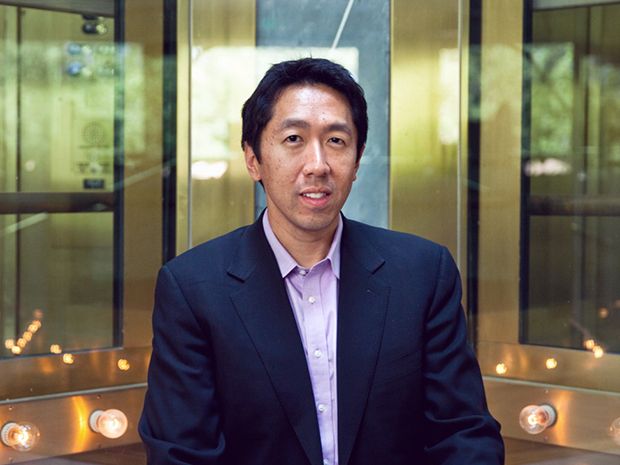Checking in with Andrew Ng at Baidu’s Blooming Silicon Valley Research Lab
The Coursera founder discusses his new gig as head of Baidu Research, Baidu’s autonomous vehicle project, and hiring plans
The road winds through a construction zone just off the intersection of the 237 and 101 freeways in Sunnyvale, Calif. Scatterings of completed buildings, sporting new plantings of drought-tolerant grasses, are already occupied; other buildings are going up quickly, including a new fire station. There’s Nissan’s new Silicon Valley research center, a well-financed medical device startup called Spiracur, a digital cash startup called Quisk, and a biotech startup incubator. And there is Baidu’s Silicon Valley AI Lab—my destination along this dusty road crowded with construction vehicles.
It’s good to spend time in a new research lab; there’s not only fresh paint and hip decor—like living walls of plants—there are fresh, excited faces, and empty desks waiting to be filled.
There’s also a bit of symmetry to this visit. In mid-2014, I spent a morning on just the other side of nearby Moffett Field watching a far more somber group of researchers moving out of a suddenly closed division of Microsoft Research. Baidu’s Silicon Valley AI Lab had quietly started a few months earlier; now it has some 60 researchers—just about the same number that moved out of Microsoft Silicon Valley. One of the first technologies to emerge from the Baidu lab, its Deep Speech system that uses a single algorithm to learn both English and Mandarin, has just starting rolling out to some users in Beijing (see video). And in January, the lab released open source AI software.
The AI researchers aren’t alone in Baidu’s building. They share the space with about 100 other engineers and computer scientists working on other projects for the giant Chinese search company. Baidu is generally tapping into Silicon Valley talent to work on a variety of projects; the fastest-growing one besides AI is autonomous vehicle research.
The AI Lab and the autonomous vehicle group are both led by Andrew Ng, a professor at Stanford since 2002 (he holds the title “associate professor by courtesy” and continues to teach one class). He started the Google Brain project in 2011, and, while at Stanford, launched the first successful massive open online courses (MOOCs). In 2012, he spun them off to start the educational technology company Coursera. Today Ng, as chief scientist for Baidu, oversees the company’s research around the world, including the Silicon Valley AI Lab, as well as the company’s Institute of Deep Learning and Big Data Lab, both in Beijing.
Here’s what Ng has to say about how research works at Baidu, Baidu’s autonomous vehicle strategy, and plans for expansion.
On moving from Stanford to corporate research:
The pace here is much different from a university. At universities, the gap between publishing a paper about research and using the research to help normal people is huge. You would publish a paper, then, two years later, someone might read it who decides to work on it further, and years later it becomes something. Here the cycles of innovation are much faster.
We also think about research differently. Our goal is to help people, but the world has an infinite supply of interesting and important problems. We might have 50 projects we’d like to tackle—and we rely on feedback from users to help us prioritize them. That enables us to do better research.
We do indeed do basic research here; like a university, we value basic research. But we are an end-to-end research organization, we don’t want to throw a project over a wall, we want to follow it through to the end.
On Baidu’s approach to autonomous driving technology:
We believe the approach of creating a car that can autonomously drive everywhere and be safe everywhere is beyond today’s technology. Instead, we are looking initially at shuttle routes and bus routes, routes that are, perhaps, a modest 20 miles, driven in a big circle, or back and forth.
We think if all you are doing is driving a 20-mile route, the technology is indeed within striking distance of making that safe. We plan to commercialize this in three years and will be moving aggressively to get this to market.
On the government’s role in advancing autonomous vehicle technology:
With a modest change in regulations, you can bring autonomous vehicles into use much quicker. For example, a computer today cannot reliably distinguish between a construction worker waving at you to “stop” vs. “go.” By giving these workers a different way to communicate with the car—perhaps an app, or wireless beacon, or special signage—we can make the interaction clearer. The technology and regulations should be developed simultaneously. I hope to see the U.S. government and tech community working together on this.
On hiring plans:
We’ll be growing the Silicon Valley AI Lab and our autonomous driving presence significantly. I don’t have specific numbers to announce yet, but we will be hiring a significant number of people.
Updated 12 February 2016
Tekla S. Perry is a senior editor at IEEE Spectrum. Based in Palo Alto, Calif., she's been covering the people, companies, and technology that make Silicon Valley a special place for more than 40 years. An IEEE member, she holds a bachelor's degree in journalism from Michigan State University.
